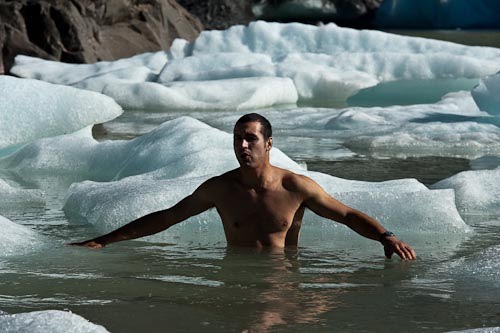Early helicopter flights ferry those seeking to catch yet more trout off to the lakes of Trebol. Two of our group leave the yacht as soon as dawn breaks and the helicopter returns to take a second group of four out to a lake at Rodriguez where they have chosen to camp overnight in what can only be called an attempt at male bonding and recreating days of when they were all Boy Scouts.
We use the bright red wasp-like machine lifting of the helideck on the stern of Atmosphere at a much more civilised 0900 and head off over the low lying River Palena where we had earlier dropped anchor after a short southward journey of just 18 nautical miles.
Our pilot flies us off across the muddy estuary and heads for the hills. Ahead of us is the Volcano of Melimoyu with its snow-capped peak. Far below us, the clouds clump together like soft cotton wool to create a white fleecy blanket. Wearing headphones into which Francisco pipes the contents of his iPod we cannot hear the cameras clicking, both of the guides and Frances are busy shooting the scenery.
In the days of film there would have been many changes of film cassette during this flight. The Bell 407 can take off and land at altitudes of up to 12,000 feet and can when flying reach an altitude of 22,000 feet so we are well within its limits as we skim across the peaks.
We are dropped off onto a natural landing pad of flat ground right at the foot of a Glacier some 2,200 feet above sea level. This is only the fourth occasion that a helicopter from Atmosphere has landed here and the area is so remote it is highly unlikely that any others have ever done so and standing upright once the aircraft has taken off and left us we get a real feeling of being a pioneer.
There is a deep ravine on one side of us gouged out of the earth by centuries of ice erosion. On the other side of over valley is a high cliff that is heavily forested. In the middle however is the formidable glacier that is so spectacular that you immediately begin to winder where Big Foot is or at the very least, a polar bear!
The icy face of the glacier, thousands of years old, blue with age is riddled with caves caused by the erosion at the point where the face meets the lagoon. Around us the ice cracks like thunder, chunks of white rock fall into the lagoon and shuttle off to join the other mini icebergs that litter the surface.
Despite water temperatures well below freezing the call of he water and the extreme sense of adventure is too much for Ignacio one of our guides who strips off and jumps in using icebergs like a surfer uses boards.
We explore our surroundings and learn from our guides all about the Nalcas, which we are told, are the sacred plant of the Mapuche the tribe of indigenous Indians who originally inhabited the central and southern parts of Chile. Pablo explains how they can be used as a foodstuff and building material.
The sun is up, layers of clothes worn just in case it was cold and windy up here have been discarded and the only fly in the ointment so to speak is the dreaded Tabano horse fly, seemingly the size of a fight aircraft which buzz around our ears incessantly pausing only to sink its long drill like stalk into your skin as they try to suck up your blood.
We discard the contents of our bottles of so called natural water and reuse them filling with the real thing from a bubbling stream. Leave them on the ice for a few minutes and low and behold Mother Nature has looked after us yet again.

